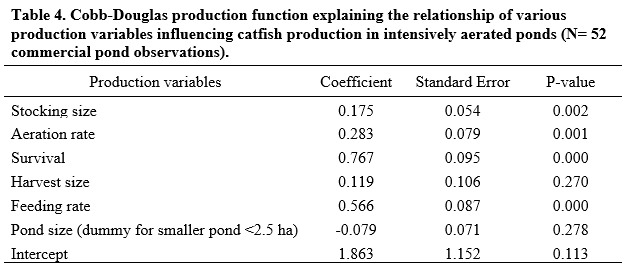PRODUCTION ECONOMIC RELATIONSHIPS IN INTENSIVE CATFISH PRODUCTION SYSTEMS
The US catfish industry is evolving by adopting intensive farming practices such as intensively aerated pond and split-pond systems. The functional relationship between fish yield and key production inputs in these intensive systems was separately analyzed employing commercial catfish production data from over 143 pond observations. Production functions such as Cobb-Douglas, translog, and modified translog production functions were employed to define functional relationships between key input and fish yield in these two intensive catfish production systems. Choice of appropriate models was made after considering the measures of fitness (R2, adjusted R2, root mean square error, Akaike Information Criterion, and Bayesian Information Criterion) as well as minimizing econometric issues such as heteroskedasticity and multicollinearity. A Cobb-Douglas production function recognized the size of fingerlings at stocking, aeration rate, survival, and feeding rate as statistically significant variables influencing fish production in intensively aerated pond systems. A modified-translog function identified variables such as initial fingerling stocking biomass, feed conversion ratio, feeding rate, and pond size as important variables influencing production in split-pond systems. Although the latter model had weak heteroskedasticity (P= 0.05), such occurrences are common given the high variance in input usage in commercial-farm data. Nevertheless, the high predictive power of this modified-translog function provides meaningful estimates of the functional production relationship. The quantity of feed used in the ponds was found as an important variable in both models. Both production functions indicated further room for improvement in use of inputs to increase production. The study provides insights into input elasticities, magnitude, and direction of effect of key production inputs on fish production in intensive catfish production systems.
